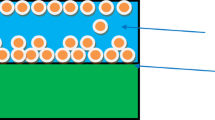Abstract
The effect of extracts of yellow colour ripe arecanut husk on the inhibition of Al corrosion in 0.5 M HCl solution was examined through weight loss and electrochemical techniques. Weight loss results show that yellow colour ripe arecanut husk extract acts as a good adsorption green corrosion inhibitor for Al metal in 0.5 M HCl solution. The protection efficiency of the inhibitor varied with the inhibitor concentration. The protective action of the yellow colour ripe arecanut husk extract increased with the increase in its amounts in 0.5 M HCl solution. The Langmuir isotherm model shows that yellow colour ripe arecanut husk extract inhibits the Al corrosion in 0.5 M HCl solution by adsorption mechanism. Tafel curves proved that yellow colour ripe arecanut husk extract is mixed-type inhibitor. Results of Nyquist curves confirmed that adsorption of yellow colour ripe arecanut husk extract species led to a enhance in charge transfer resistance values and decrease in the values of double-layer capacitance. Both scanning electron microscopy and atomic force microscopy techniques are used to examine the Al surface morphology without and with the yellow colour ripe arecanut husk extract.
Graphical Abstract
Protection efficiency obtained by chemical and electrochemical techniques at different inhibitor concentrations.












Similar content being viewed by others
References
Lee EJ, Pyun SJ (1995) The effect of oxide chemistry on the passivity of aluminum surfaces. Corros Sci 37:157–168
Mahmoud El-Haddad N, Fouda AS (2015) Electroanalytical, quantum and surface characterization studies on imidazole derivatives as corrosion inhibitors for aluminum in acidic media. J Mol Liq 209:480–486
Nestoridia M, Pletcher D (2008) The study of aluminium anodes for high power density Al/air batteries with brine electrolytes. J Power Sources 178:445–455
Sherif EM, Park SM (2006) Effects of 1, 4-naphthoquinone on aluminum corrosion in 0.50 M sodium chloride solutions. Electrochim Acta 51:1313–1321
Khadraoui A, Khelifa A, Hachama K, Mehdaoui R (2016) Thymus algeriensis extract as a new eco-friendly corrosion inhibitor for 2024 aluminium alloy in 1 M HCl medium. J Mol Liq 214:293–297
Fares Mohammad M, Maayta AK, Al-Qudah Mohammad M (2012) Pectin as promising green corrosion inhibitor of aluminum in hydrochloric acid solution. Corros Sci 60:112–117
Nnanna LA, Onwuagba BN, Mejeha IM, Okeoma KB (2010) Inhibition effects of some plant extracts on the acid corrosion of aluminium alloy. Afr J Pure Appl Chem 4:11–16
Rosaline Vimala J, Leema Rose A, Raja S (2011) Cassia auriculata extract as corrosion inhibitor for mild steel in acid medium. Int J ChemTech Res 3:1791–1801
Perumal S, Muthumanickam S, Elangovan A, Karthik R, Sayee kannan R, Mothilal KK (2017) Bauhinia tomentosa leaves extract as green corrosion inhibitor for mild steel in 1 M HCl medium. J Bio Tribo Corros 3:13
Fouda AS, Megahed HE, Fouad N, Elbahrawi NM (2016) Corrosion inhibition of carbon steel in 1 M hydrochloric acid solution by aqueous extract of thevetia peruviana. J Bio Tribo Corros 2:16
Paul S, Koley I (2016) Corrosion inhibition of carbon steel in acidic environment by papaya seed as green inhibitor. J Bio Tribo Corros 2:6
Tezeghdenti M, Dhouibi L, Etteyeb N (2015) Corrosion inhibition of carbon steel in 1 M sulphuric acid solution by extract of eucalyptus globulus leaves cultivated in tunisia arid zones. J Bio Tribo Corros 1:16
Gusti DR, Emriadi, Alif A, Efdi M (2017) Corrosion inhibition of ethanol extract of cassava (manihot esculenta) leaves on mild steel in sulfuric acid. Int J ChemTech Res 10:163–171
Raghavendra N, Ishwara Bhat J (2017) Chemical and electrochemical studies on the areca fat as a novel and sustainable corrosion inhibitor for industrially important materials in hostile fluid environments. J Bio Tribo Corros 3:12
Yadav S, Choudhary G, Sharma A (2013) Green approach to corrosion inhibition of aluminium and copper by ziziphus mauritiana fruit extract in hydrochloric acid solution. Int J ChemTech Res 5:1815–1823
Raghavendra N, Ishwara Bhat J (2016) Natural products for material protection: an interesting and efficacious anticorrosive property of dry Arecanut seed extract at electrode (aluminum)–electrolyte (hydrochloric Acid) interface. J Bio Tribo Corros 2:21
Anupama KK, Shainy KM, Joseph Abraham (2016) Excellent anticorrosion behavior of Ruta Graveolens extract (RGE) for mild steel in hydrochloric acid: electro analytical studies on the effect of time, temperature, and inhibitor concentration. J Bio Tribo Corros 2:2
Raghavendra N, Ishwara Bhat J (2016) Green approach to inhibition of corrosion of aluminum in 0.5 M HCl medium by tender Arecanut seed extract: insight from gravimetric and electrochemical studies. Res Chem Intermed 42:6351–6372
Oguzie EE (2007) Corrosion inhibition of aluminium in acidic and alkaline media by Sansevieria trifasciata extract. Corros Sci 49:1527–1539
Abdel-Gaber AM, Abd-El-Nabey BA, Sidahmed IM, El-Zayady AM, Saadawy M M (2006) Inhibitive action of some plant extracts on the corrosion of steel in acidic media. Corros Sci 48:2765–2779
Valek L, Martinez S (2007) Copper corrosion inhibition by Azadirachta indica leaves extract in 0.5 M sulphuric acid. Mater Lett 61:148–151
Raghava V, Baruah HK (1958) Arecanut: India’s popular masticatory-history, chemistry, and utilization. Econ Bot 12:315–345
Nagaraja R, Gurumurthy BR, Shivanna MB (2014) Bio softening of arecanut waste areca husk, leaf and leaf sheath for value added compost. Int J Res Appl Nat Soc Sci 2:105–112
Govindarajan VS (1968) Arecanut growing in north east India. Indian Farming 18:26–30
Nayar A (1997) The metals databook. Tata McGraw-Hill, New Delhi. ISBN 0070460884
Fontana MG (1987) Corrosion engineering. McGraw Hill, Singapore
Acknowledgements
The authors (N. Raghavendra and J. Ishwara Bhat) are most grateful to Dr. B. E Kumaraswamy, Kuvempu University, for an electrochemical instrument facility.
Author information
Authors and Affiliations
Corresponding author
Ethics declarations
Conflict of interest
The authors declare no conflict of interest.
Rights and permissions
About this article
Cite this article
Raghavendra, N., Ishwara Bhat, J. An Environmentally Friendly Approach Towards Mitigation of Al Corrosion in Hydrochloric Acid by Yellow Colour Ripe Arecanut Husk Extract: Introducing Potential and Sustainable Inhibitor for Material Protection. J Bio Tribo Corros 4, 2 (2018). https://doi.org/10.1007/s40735-017-0112-1
Received:
Revised:
Accepted:
Published:
DOI: https://doi.org/10.1007/s40735-017-0112-1




